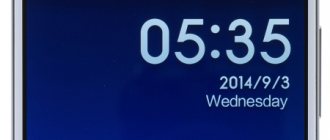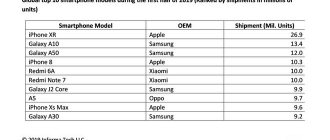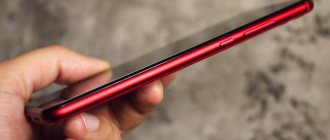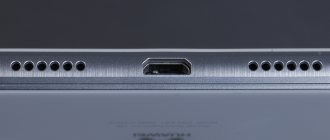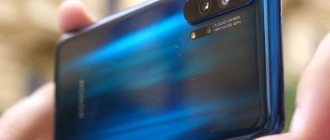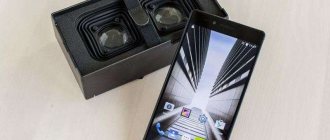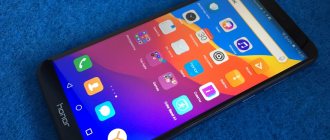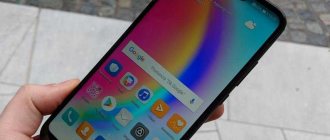Compared to its predecessor, this smartphone, made in a modern, catchy design, boasts not only a more powerful processor, but also an increased diagonal of an edge-to-edge display with a teardrop-shaped “notch”, a high-resolution selfie camera with AI functions, a higher-capacity battery, and a fresh system software. In this review of Huawei Honor 10 Lite, we will find out its main advantages and disadvantages.
So, a new smartphone has appeared in the line under the Honor brand, claiming to become the successor to one of the best-selling budget devices of 2018 in Russia - Honor 9 Lite (our review here). Taking into account the orientation of this brand towards a youth audience, the main emphasis in Honor 10 Lite is on the attractiveness of the exterior and improving the capabilities of the cameras. In particular, both photo modules of the new smartphone now support AI functions. Despite the hardware and software upgrade, Honor 10 Lite remained in the same price category.
Huawei Honor 10 Lite review: technical specifications
- Model: HRY-LX1
- OS: Android 9.0 (Pie) with EMUI 9.0.1 shell
- Processor: 12nm 8-core 64-bit HiSilicon Kirin 710 (4x ARM Cortex-A73 2.2GHz + 4x ARM Cortex-A53 1.7GHz)
- Graphics subsystem: ARM Mali-G51 MP4
- RAM: 3 GB
- Built-in memory: 32 GB/64 GB, combined microSD/HC/XC memory card slot (up to 512 GB)
- Interfaces: Wi-Fi 802.11 b/g/n (2.4 GHz), Wi-Fi Direct, Bluetooth 4.2 (LE), microUSB (USB 2.0, OTG), NFC
- Screen: capacitive, touch, LTPS IPS, 6.21-inch diagonal, resolution 2340x1080 pixels (19.5:9), pixel density per inch 415 ppi, 90% front panel
- Rear photo module: main camera - 13 MP, wide-angle lens, phase detection autofocus, f/1.8 aperture, secondary camera - 2 MP, f/2.4 aperture, LED flash, video [ email protected] fps, AI: portrait mode, AIS- stabilization, 22 categories (500 scenes)
- Front camera - 24 MP, wide-angle lens, f/2.0 aperture, 8 categories (200 scenes), video [email protected] fps
- Network: 2G, 3G (HSPA+, up to 42 Mbit/s), LTE Cat. 4 (up to 150 Mbit/s), LTE-FDD b1, b3, b5, b7, b8, b20
- SIM card configuration: nanoSIM (4FF format) + nanoSIM (4FF format)/microSD/HC/XC
- SIM card operating mode: Dual SIM Dual Standby (DSDS)
- Radio: FM tuner
- Navigation: GPS/BDS/GLONASS, A-GPS
- Sensors: accelerometer, compass, lighting and proximity, fingerprint scanner
- Battery: non-removable, lithium polymer, 3,400 mAh, charging adapter (5 V/2 A)
- Colors: Midnight Black, Gradient Sapphire Blue, Gradient Sky Blue
- Dimensions: 154.8x73.64x7.95 mm
- Weight: 162 g
Review of Huawei Honor 10 Lite: design, ergonomics
The success of the “handsome” Honor 10 (our review here) clearly left its mark on the design of its fleshed-out version, which, by the way, echoes the appearance of the device under a related brand – Huawei P smart 2020 (our review here).
The Honor 10 Lite abandoned aluminosilicate glass, like the older model, in favor of 8-layer plastic (also glass, but acrylic).
Visually this is not too noticeable; moreover, the surface seems to be the same grade and slippery. In addition to midnight black, there are also sapphire blue and sky blue colors (both of the latter are gradient).
Here, for example, is how the blue and green gradient colors were explained for Honor 10 using a virtual chameleon.
Unlike last year’s bestseller Honor 9 Lite, which still did without a notch, Honor 10 Lite had a beautiful teardrop-shaped cutout at the top of the screen, on which the front camera lens was placed. The frames around the display, which now occupies about 90% of the front surface, are, of course, thinner.
With dimensions of 154.8 x 73.64 x 7.95 mm, the weight of the new product is 162 g. These dimensions approximately correspond to a smartphone with a 5.2-inch display with an aspect ratio of 16:9. The screen of the Honor 10 Lite, covered with glass with a 2.5D effect, apparently had a protective film applied at the factory.
The neat teardrop-shaped cutout at the top of the screen accommodates only the front camera lens, and the narrow speaker grille is located just above it, almost at the junction with the top end.
The “triangle”, “circle” and “square” icons, representing the on-screen touch control buttons “Back”, “Home” and “Recent applications”, can not only be swapped in the settings, supplemented with another button, but also, in general, replaced gestures. On the “chin”, which is wider than the rest of the frames, there is a tiny LED event indicator.
The left edge of the body is empty.
On the right edge are equally thin, but different in size, volume rocker and power/lock button.
At the top end of the smartphone, next to the hole for an additional microphone, there is a closed slot with a tray for two places, one of which is specifically designed for the subscriber identification module (nanoSIM), and the other is divided on an alternative basis between a microSD memory card and a second nanoSIM.
The microUSB connector at the bottom is surrounded by a decorative grille for the “multimedia” speaker, a hole for the “talk” microphone and a 3.5 mm audio headset connector.
The lenses of the rear photo module, together with the LED flash, are placed vertically at the top of the rear panel, closer to the left edge, and are accompanied by the inscription AI Camera.
From the text at the bottom of the back panel, also decorated with the Honor logo, you can find out the model number, company name and country of production.
Despite the seemingly impressive screen size, the smartphone, thanks to the correctly chosen aspect ratio, lies quite comfortably in the palm of your hand. However, the silicone clip case is included in the kit not at all to simply cover the spectacular back panel of the Honor 10 Lite.
Appearance
| Weight | 162 g |
| Size | 154.8 x 73.64 x 7.95 mm |
| Protection | No |
We sell three colors - blue, blue, black. In China you can still find something pink and red.
The smartphone looks simple. Colored versions might be more fun. My black one, to be honest, was not at all impressive. Soapy, glossy, plastic. Don't carry it without a case, don't. Very slippery.
What’s nice is that for once the cameras don’t stick out too much. The smartphone is able to lie quietly on the table and not wobble even without a case.
There is an LED.
The card tray is located on the top edge. Everything would be fine, but next to the hole for the paper clip there is a microphone hole for noise reduction. Don't get confused where to point!
For anyone interested in the strength of the device, I recommend watching this ten-minute video.
Traditional boring details
At the top there is a cutout in which the front camera is hidden. Above it is a speaker strip. Around the same place (to the right of the cutout) is a proximity sensor.
Below the screen there is an LED and, oddly enough, a light sensor. I think this is the first time I've seen it under the screen.
Everything at the back is traditional. The cameras are moved to a corner, the fingerprint scanner is in the center.
Top edge.
Bottom edge. There is a 3.5 mm audio output, a speaker, a Micro-USB connector, and a main microphone.
On the right side there are buttons. Traditional volume rocker and power button.
On the left side there is a swimming pool, a barbecue and a bicycle, because no one reads the boring details anyway.
Huawei Honor 10 Lite review: screen
The Honor 10 Lite smartphone is equipped with a 6.21-inch screen (aspect ratio 19.5:9), on which the FHD+ resolution (2340x1080 pixels) provides a pixel density per inch of 415 ppi. To manufacture the matrix, like the Honor 10, LTPS (Low Temperature Poly Silicon) technology was used. As is known, replacing amorphous silicon with polycrystalline silicon allows one to achieve wider viewing angles, a better color palette, lower power consumption and response time. Let us remind you that the Honor 9 Lite has a 5.65-inch screen, and the matrix technology is regular IPS (18:9 aspect ratio, resolution 2160x1080 pixels, dots per inch density 428 ppi, and no notch).
The screen brightness in Honor 10 Lite can be adjusted manually or using the “Auto Adjust” option. The capacitive touch screen recognizes up to ten simultaneous clicks, which was confirmed by the results of the MultiTouch Tester program. The vision protection mode, activated according to a schedule, reduces eye strain when working with a smartphone for a long time. The intensity of the blue filter (“color temperature”) is independently regulated in the “cold-warm” range.
The Color Mode and Temperature tab contains a color wheel and three presets (Default, Warm, and Cool) to determine color temperature. At the same time, there are two options for the color scheme - “Bright” and “Normal”. The high screen resolution FHD+ (2340×1080 pixels) can be changed to a lower one – HD+ (1560×720 pixels), and the choice of the “Smart Resolution” option is provided for additional energy saving. Drop-shaped “bangs” can be easily hidden against a dark background if desired.
Along with the “simple” mode (larger icons and text), the settings included switching between two screen styles - normal and with a separate application menu. The Full Screen Display tab contains programs that are not optimized for full screen mode. The display glass is covered with a protective film with an oleophobic coating.
What does he look like?
Honor 10 Lite is packaged in a non-slip plastic case, easily soiled on the back and perfectly protected from fingerprints on the display side. The frames around the display are minimal, thanks to this, rounded body and thickness of only 8 mm, the model fits comfortably in the palm of your hand, even in a case.
We had a blue smartphone for review. And it seems to me that saturation and hue have already become a recognizable feature for the brand (both Honor and Huawei). In any case, I cannot offhand name a single “brother” in color for this device from the lines of other manufacturers.
In terms of appearance, the model has surpassed the usual “ten” - the frames are thinner, the cutout on the display is smaller. It is much more convenient to live with a “drop” than with a “unibrow”. Firstly, finally applications have really adapted to the cutout, and secondly, it practically does not fall into the field of view on the screen and does not cover significant parts of the interface. And it doesn’t irritate with its uselessness. Definitely, the move to waterdrop notches is one of the best changes in smartphone design in recent times.
An LED indicating missed events is located at the bottom of the device. It's tiny - and that's super convenient too. Because on the one hand, you can see it when necessary, on the other hand, it does not disturb you at night with its triumphant glow.
On the back of the Honor 10 Lite there are two cameras and a fingerprint scanner. In good places. The finger hits the sensor directly, as soon as you take the smartphone in your hand (it even seemed to me that because of this, I used this unlocking method much more often than facial recognition, which, by the way, also works decently). The cameras are not blocked by your fingers when shooting, and in normal life your fingers can’t reach them either, so you don’t have to wipe fingerprints off the lenses. The volume and screen lock keys are on the right, at a comfortable height.
The Honor 10 Lite still has an audio output. And the manufacturer also did not change the microUSB connector to USB Type C. On the one hand, the latter is somehow outdated. On the other hand, if you haven’t had time to switch to smartphones with Type C, then your zoo of cables with this model will still remain relevant.
The device is well assembled. I don’t know what will happen to the plastic when worn without a case, I haven’t tried it. But usually the glossy finish gets scratched quickly, so I don’t advise the potential owner of a smartphone to wear it without a case.
Huawei Honor 10 Lite review: cameras
Unlike its predecessor, the cameras on the Honor 10 Lite have become smarter, and they did not fail to remind us of this with the inscription on the back of the smartphone (AI Camera).
AI functions are supported not only by the rear, but also by the front photo module, with the first identifying 500 scenarios in 22 shooting categories, and the second – 200 in 8, respectively. This time too there were some oddities - the “brains” seemed to turn on, but the stuffed parrot was still confused with a panda.
In the rear photo module with LED flash, the main camera with a 13-megapixel sensor, phase detection autofocus and an aperture of a 5-lens f/1.8 lens is responsible for the shooting itself, and a 2-megapixel auxiliary camera with an f/2.4 aperture helps to map the depth of field. The maximum image resolution is 4160x3120 pixels (13 MP, 4:3), but when the AI option is enabled, it drops to 3264x2448 pixels (8 MP, 4:3).
In the front photo module, they abandoned the duo that was in the Honor 9 Lite, but the remaining camera (with an f/2.0 aperture) was equipped with a 24-megapixel sensor. The size of one pixel is small - 0.9 microns, but in case of insufficient lighting they can be grouped according to the “4-in-1” principle to obtain an effective size of 1.8 microns. The maximum resolution of a selfie in a 4:3 ratio is 5632x4224 pixels. It is suggested to use the screen backlight as a flash.
Both photo modules can shoot video with FHD quality (1920x1080 pixels, 16:9) at a frame rate of 30 fps, and for the rear camera the frequency can be increased to 60 fps. Compatibility is ensured by the standard H.264/AVC codec, and file size reduction is provided by H.265/HEVC (the required is selected in the settings). Thus, all content is saved in MP4 container files (AVC or HEVC - video, AAC - audio).
In the Camera app interface, icons at the top of the screen allow you to choose the flash, activate the Live Photos option, turn on the “brains” (AI functions), or go to settings. At the bottom of the viewfinder there are icons-inscriptions of the main modes, selected by horizontal swipes - “Aperture”, “Night”, “Portrait”, “Photo”, “Video” and “More” (transition to additional modes), including “Pro” (PRO), HDR, “Filter”, “Augmented Reality” (AR) and others. In Photo mode, exposure and focus metering points may vary. The brightness of the image is changed by vertical swipes (down or up) next to the focus circle.
For the rear camera duo, in Aperture mode, the virtual aperture value can be changed from 0.95 to 16. Portrait mode is enhanced by a beautification effect (ranging from 0 to 10), turning on or off the background blur option, and using emulation of four flash lighting modes (“ soft”, “scattered”, “bright”, “butterfly”).
The professional photo mode provides manual adjustment of parameters such as exposure metering method, ISO value, shutter speed, exposure compensation level, focusing method, and white balance. In the “Night” mode, you can independently change the shutter speed and light sensitivity. During such shooting, the smartphone has to be held motionless for some time, however, thanks to the “smart” stabilization AIS (AI Image Stabilization), photographs are taken without a tripod, even at shutter speeds of up to 5-6 seconds. Using the “Filter”, you can apply one of the eight available effects to the image (such as “Gentle”, “Nostalgia”, “Radiance”, etc.), and also adjust its intensity (1-32).
For proprietary artistic shooting modes "Light" you must use a tripod. Augmented Reality offers different animated effects and backgrounds. Interval shooting (Time Lapse mode) is supported only in HD quality (1280x720 pixels).
Examples of pictures from the main photo module can be viewed here.
Cameras
The equivalent focal length of the main lens is 26 mm, f/1.8 aperture. The user can choose three resolutions: 8, 10 and 13 MP. Shooting based on artificial intelligence and in “Portrait” mode is carried out only in 8 megapixel resolution.
Selfie camera with a 24 MP sensor, the equivalent focal length is identical to the main lens, but the aperture is slightly smaller - f/2.0.
Huawei Honor 10 Lite review: sound
By connecting headphones to the Honor 10 Lite, you can use Huawei's proprietary Histen algorithms. They somewhat expand the “musical” capabilities of the smartphone, when, to facilitate automatic setup, you should, for example, note the type of audio accessory being connected. By refusing to turn on the simulation of deep 3D surround sound (“close”, “front”, “surround”, “maximum”), you can choose the natural or normal mode. In the latter case, you also have access to a 10-band equalizer with bass boost, five presets and individual settings.
The Voice Recorder program records conversations in M4A format files (AAC LC, 48 kHz), and can leave quick tags on these recordings. The standard Music application plays high-quality audio files with the FLAC extension. To operate the FM tuner as a shortwave antenna, you will need a wired audio headset.
The A2DP profile for Bluetooth headphones contains aptX and aptX HD codecs.
Packaging and equipment
The smartphone comes in a cardboard box, protected from tampering with two stickers.
Contents of delivery:
- smartphone Honor 10 Lite,
- 2 amp power adapter,
- microUSB connection cable,
- clear case,
- SIM card tray clip,
- warranty card,
- quick guide.
Review of Huawei Honor 10 Lite: hardware, performance
Under the hood of the Honor 10 Lite lies a fairly recent HiSilicon Kirin 710 (12 nm) system-on-chip, specifically designed for mid-range devices.
The processor (big.LITTLE architecture), which includes two quartets of cores - four ARM Cortex-A73 (2.2 GHz) and four Cortex-A53 (1.7 GHz), works in tandem with an ARM Mali-G51 MP4 graphics accelerator. The latter supports GPU Turbo 2.0 technology, which, by dynamically changing the supply voltage and frequency, is designed to double the energy efficiency of the graphics accelerator. The mobile platform includes Wi-Fi 802.11ac, LTE Cat.12/Cat.13 and Bluetooth 4.2. The basic configuration of Honor 10 Lite is complemented by 3 GB of RAM.
Compared to the previous generation Kirin 659 chip installed in last year's bestseller Honor 9 Lite, the performance of the graphics accelerator has increased by 130% and the processor by 75%. Unfortunately, it was not possible to check this, since we received a smartphone with a preliminary version of the firmware. The main test programs (AnTuTu and GeekBench) simply refused to load from Google Play or crashed (3DMark) while running.
Testing Huawei Honor 10 Lite. AndroBench 5 benchmark results
Testing Huawei Honor 10 Lite. Results in the 3DMark benchmark
For the 3DMark gaming benchmark, we were able to use the not the most recent version from the saved apk file.
The tested smartphone had 64 GB of internal memory installed (there is a modification with 32 GB), which can be expanded with a microSD/HC/XC card with a maximum capacity of up to 512 GB. Let us remind you that in this case it will take the place of the second subscriber identification module of the nanoSIM format (4FF). If you have a USB-OTG adapter, you can easily connect a regular flash drive to your smartphone.
Two nanoSIM cards work with one radio channel in DSDS mode (Dual SIM Dual Standby), and among the FDD-LTE frequency ranges there is a “Russian troika” - b3 (1,800 MHz), b7 (2,600 MHz) and b20 (800 MHz) . A mobile terminal category has been defined for the smartphone - LTE Cat.4, which allows 4G networks to reach speeds of up to 150 Mbit/s for reception. The wireless communications suite also includes Wi-Fi 802.11 b/g/n (2.4 GHz), Bluetooth 4.2 (LE) and NFC interfaces. But the high-frequency 5-GHz Wi-Fi range is still missing.
At the presentation, it was noted that the smartphone supports three simultaneous connections via Bluetooth (usually only one), for example, to headphones, smart watches and a wireless monopod.
Thanks to the NFC interface, you can use, for example, the Android Pay payment service, and in tandem with the Moscow Transport Cards program, be aware of the Troika balance. In addition, the proprietary “Party” application using NFC suggests combining several smartphones in one Wi-Fi network to organize surround sound.
GPS, GLONASS and BDS satellite constellations are used to determine the exact location and navigation. A-GPS mode is necessary for coordination over cellular and Wi-Fi networks.
- Design
Honor 10 Lite features an elongated display, a vertically positioned dual rear camera at the center, a center-mounted fingerprint sensor and an attractive body with a stylish reflective design.
At first glance, it is a nice looking phone that is in line with the company's other late 2020 phones. At markets, you'll be able to pick up the Lite in Midnight Black, Sapphire Blue, or the royal blue color I tested. It doesn't offer the same level of pearlescent or visual impact as the original Honor 10's Phantom Blue, but it's still nice to look at.
Verdict
As already noted, Honor 10 Lite turned out to be a little unfinished. Poor performance out of the box, but a powerful feature set means it's worth a look.
WoWMooN.ru
- Design
6
- Price
9
- Autonomy
8
- Performance
6
- Connection
8
pros
- Attractive design
- Decent battery life
- Multifunctional
Minuses
- The software is missing key features
- Poor gaming performance (upgrade to GPU Turbo 2.0)
- Prone to fingerprints
- Plastic assembly
7.4 3.7 5
Overall Score
Take it in your hand and you'll immediately notice that although it looks like it's made of glass and metal, it has an all-plastic construction. The back part, when touched, makes the sound of an empty cavity and bends under the finger; It feels cheaper than it looks, which is a shame in everyday use. The shiny back, along with the display, comes with a pre-installed screen protector. It picks up smudges and fingerprints too easily, so be prepared to clean this phone frequently if you decide to ignore the included case.
The phone's hardware controls (the volume rocker and the power key underneath) operate on the right side of the case. They feel perfectly durable, sturdy and should be within easy reach for most users, but like the body, they're made of plastic rather than metal, reinforcing the phone's position as a budget smartphone.
Huawei Honor 10 Lite review: autonomy
The capacity of the built-in battery, compared to Honor 9 Lite, has increased from 3,000 mAh to 3,400 mAh. To fill it “to the neck” through a standard adapter (5 V/2 A), it will take about 150 minutes. This is quite long and, of course, not very convenient. Fast charging in this case would not hurt at all. The manufacturer notes that a full tank will be enough for 19 hours of calls on 3G networks or 612 hours of standby time. A set of test videos in MP4 format (hardware decoding) played continuously at full brightness for almost 9 hours.
The settings in the “Battery” section allow you, for example, to decide on an energy saving mode, as well as take advantage of tips for optimizing energy consumption. When the battery level is low, it is recommended to switch to Ultra mode, where only selected programs are available.
Communication, NFC and battery
Honor 10 Lite liked the stable connection even in those places where the operator signal is very weak. 4G mode is available for both SIM cards, which is important. Other wireless interfaces also work without problems, including Bluetooth 4.2 LE, GPS and GLONASS. The built-in compass and gyroscope will delight those who like to navigate not only in the urban jungle, but also on real hikes - it works quickly and accurately. The sound of the calling speaker is ringing and clear; the earpiece is also worthy of praise for conveying all shades of the interlocutor's voice.
It is especially worth noting the presence of an NFC module, the activation of which is visible in the top menu of indicators. The trendy short-range wireless data transmission feature will be useful for advanced users for contactless payments. As for the Wi-Fi module, it is implemented here only in the 2.4 GHz band with the n protocol, providing fairly high Internet access speeds.
The smartphone is equipped with a capacious 3400 mAh Li-Po battery without fast charging function. Our test unit was supplied without an adapter, so we had to charge it with a third-party power supply (from Xiaomi Mi Max) with parameters of 5 V, 2 A. The charging time from 16 to 100% was 2 hours 20 minutes. Test measurements of the smartphone's battery life in different modes showed the following results:
- Talk time on 3G network: 27 hours.
- Web surfing mode (70% brightness): 11 hours.
- Video playback mode (70% brightness): 11h 30m
- Game mode (World of Tanks Blitz) (70% brightness): 4 hours
Huawei Honor 10 Lite review: software features
The Honor 10 Lite smartphone runs on the Android 9 (Pie) operating system, the interface of which is replaced by the proprietary EMUI 9 shell (see our review here). In this launcher, you can switch from the usual style of the home screen, when all program shortcuts are collected on desktops, to a style with a separate application menu (screen). A swipe from the top edge of the screen opens the notifications and quick settings panel, and a tap and hold on the application icon brings up a menu for accessing frequently used functions.
You can decide, for example, on the effect of transition between screens, select the desired widget, and also change the grid of application icons in the home screen settings.
The virtual panel offers four combinations of icons (“Back”, “Home”, “Recent applications”, and “Calling the notification panel and quick settings”), which can be easily hidden by activating the corresponding option. Icons can be replaced with gestures, and, in addition, both methods can be supplemented with an additional navigation button.
In the “Digital Balance” section you can easily limit the time you can use any application.
The launcher used can divide the screen between two applications and make a screencast (video recording) from it. In addition, the options from the “Movements” section will help you control your smartphone.
After registering (up to five) fingerprints, in addition to quickly unlocking the smartphone, it is easy to organize secure access to personal folders and applications. The scanner's touch pad will help you answer voice calls, turn off the alarm, open the notification panel, scroll through images, and activate photo or video shooting from the Camera application. Moreover, fingerprint registration is not required for this.
Facial recognition is an additional option for unlocking Honor 10 Lite. However, in practice, this procedure did not cause positive emotions, since, especially in the dark (when backlit by the screen), problems periodically arose. It is impossible to register wearing dark glasses, and in general it is better to do without any glasses. However, you can reassure yourself that facial recognition is a less reliable method of protection than a password, pattern or PIN code.
Video shooting
Video mode. There are 4 recording modes available, the most productive is FullHD with 60 frames per second.
Example 1. Sunset. The camera's white balance and exposure are correct.
When making jerks, there is no picture, the exposure is adjusted smoothly.
Example 2. Last rays of the sun, twilight. When the light decreases, it is more difficult for the camera to maintain focus.
The first video - everything is fine with focus. The sensitivity of the microphone is selected correctly - there is no overload of sound, no clicks from the violin. Voices and instruments do not merge.
Second video - the light became less, at 1:10 the camera refocused, but with a slight miss. Changes in the scene are minimal, so focus is not adjusted. At 3:04 the musician changes position slightly and the camera focuses accurately.
It is difficult to classify the defect as a critical problem, since the scene is far from the simplest - twilight and a minimum of changes in the frame. In this situation, rather, advice to users: in such conditions, be a little more attentive to focusing.
Example 3. Deep twilight. It is difficult for the camera to set the exposure correctly and not extrude areas that have virtually no details.
The smartphone overestimates the exposure by half a stop, which is not much (the video was shot with adjustments). You can correct it quickly enough by simply moving your finger down from the focal point.
When shooting at night, detail is noticeably reduced. At FullHD resolution at 60 fps there is a lot of noise, so it is wiser to choose modes at 30 fps.
Time Lapse mode allows you to record time lapses. Resolution is only 720p. Every 14 seconds the video is compressed to 1 second. Tripod required.
